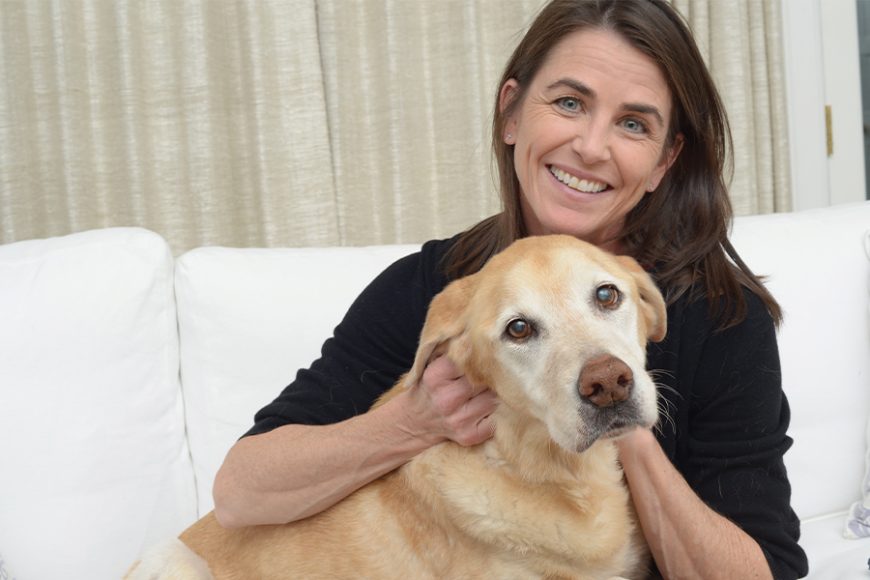For many who are on the boards of medical organizations, the cause is personal. Such is the case with Shelby Saer, co-chairman of the board of governors of the Robert Packard Center for ALS Research at Johns Hopkins in Baltimore, which celebrates its 20th anniversary this year.
Saer’s maternal grandfather, Edgar Gwin Shelby, developed ALS — amyotrophic lateral sclerosis — in his 60s and died at age 72. Her mother, Jo Gwin Shelby, a New Orleans schoolteacher, was 57 when she was diagnosed with ALS and died at age 65 on Aug. 29, 2011.
“She retired from teaching … and lived with us (in Greenwich) the last three years of her life,” Saer says. “My mother learned to drive a wheelchair with her chin and tongue and use a computer with her eyes. She had a service dog, Lolly, a yellow Lab who is still with us at age 14.”
While 90% of ALS cases are sporadic and only 10% are familial, inherited through a mutated gene, Saer says she sometimes thinks about a future in which she could have the disease. She is counting on her family for support.
“My husband, John (former Packard Center board co-chair), was a rock and said, ‘You’re an only child. Your mom needs to be with us.’” Saer says she jokes with her children — Kenneth, Tobin and Julia — that if the time comes, they’ll have to show the same care for her that they did for their grandmother.
She knows, however, that ALS is no laughing matter. Also called Lou Gehrig’s Disease — for the legendary New York Yankees first baseman who died of the illness on June 2, 1941 at age 37 — ALS is a rare neurological disorder affecting some 30,000 people in the United States. It causes motor neurons to shrink and die off. Over time, the loss of these neurons in the brain and spinal cord results in loss of voluntary muscle control that leads to paralysis and difficulty in speaking, swallowing and, ultimately, breathing. The average life expectancy is two to five years from diagnosis, Saer says.
“For so long, a disease like ALS has been seen as an orphan disease,” she says, “because not enough people have it to fund a lot of research.”
That’s why she wanted to become involved with the Packard Center, which represents a new trend in collaborative medical research.
“Twenty years ago, ALS scientists worked in silos,” she says.
“The Packard Center developed a model that brought them together to critique each other and share information. It’s a collaborative approach that is now used in other diseases,” Saer says, crediting Dr. Jeffrey Rothstein, the center’s founding director.
Progress has been slow. “ALS is a difficult disease to diagnose. There is no one test or procedure to ultimately establish the diagnosis of ALS. It is through a clinical examination and series of diagnostic tests, often ruling out other diseases that mimic ALS, that a diagnosis can be established.”
And yet, progress has been made. Saer notes that it took 25 years to discover the role that the SOD1 gene plays in familial ALS but just over eight years to uncover the C9orf72 gene’s role.
She is particularly excited by the center’s Answer ALS study, inspired by co-founder Steve Gleason — a former New Orleans Saints safety who disclosed his ALS in 2011 — and an advisory board that includes two other ALS patients and caregivers. To date, the group has raised $40 million for the study, which involves 1,000 patients from eight clinical sites across the country.
“It’s the single largest and most comprehensive ALS research project in history,” she says, “producing more ALS data than has ever been amassed, while openly sharing it with the global research community …The project will use that data to investigate the unique pathways of each variation of ALS and begin to develop the right treatments or cure.”
Saer doesn’t see that treatment or cure coming in her lifetime, but looks to one in her children’s. For her, “it’s an honor” to be part of that future.
“It took me a while to get involved,” she says. “But I’m all in now.”
The Robert Packard Center for ALS Research at Johns Hopkins in Baltimore holds its 20th annual symposium March 2 through March 4. For more, visit packardcenter.org.


